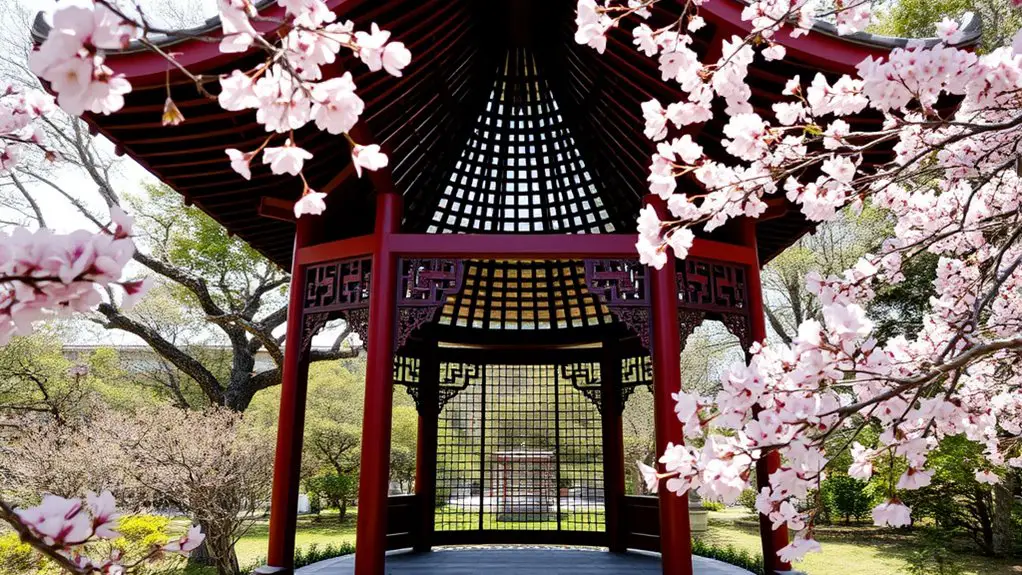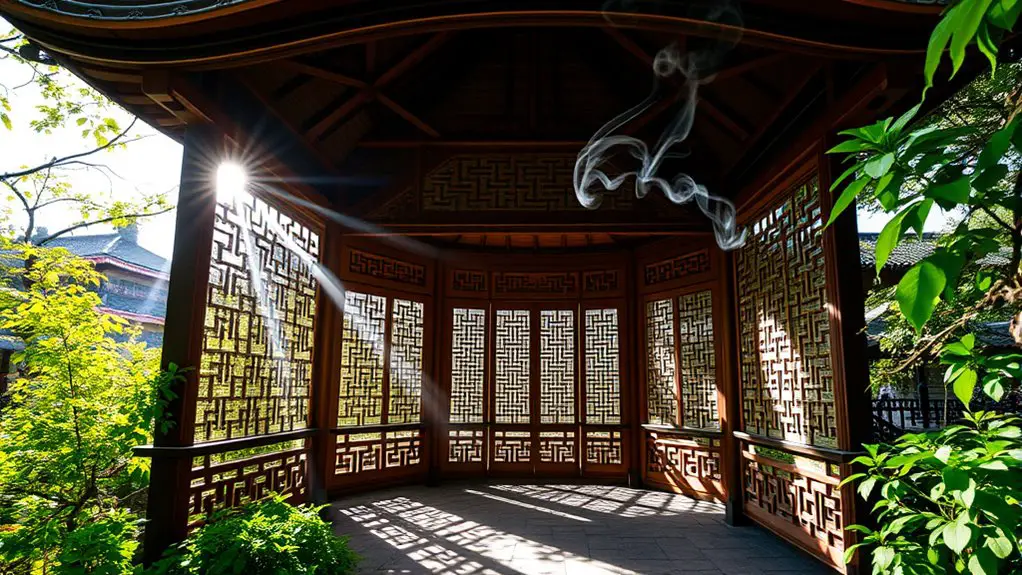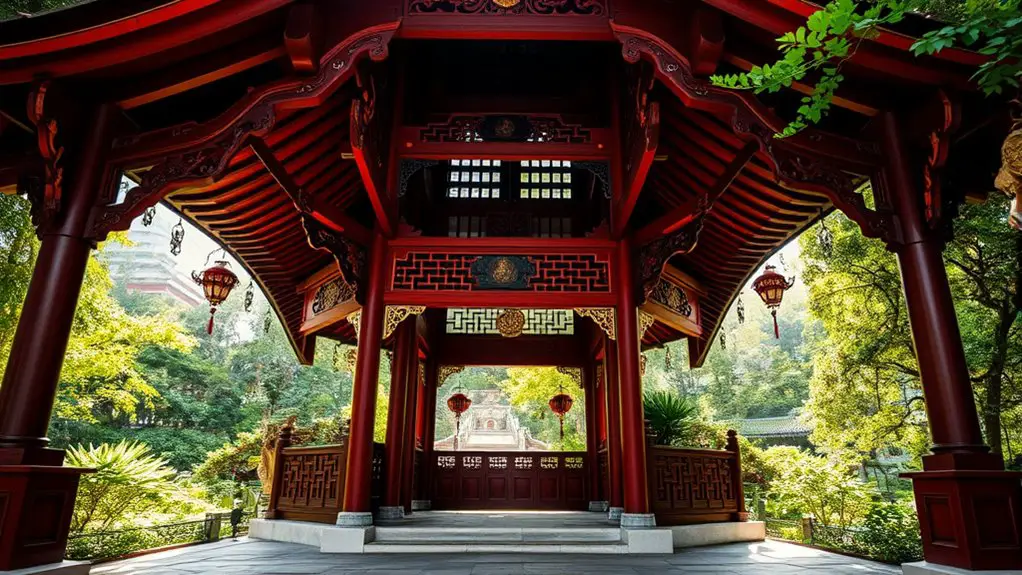Chinese-inspired gazebo designs offer a beautiful mix of elegance and cultural meaning. You’ll notice traditional pagoda-style roofs with gracefully curved eaves, symbolizing harmony with nature. Intricate latticework not only enhances visual appeal but also conveys social connections. Incorporating vibrant colors like red and yellow evokes happiness and prosperity. The use of natural materials ties the structure to its surroundings. If you explore further, you’ll discover tips on enhancing your garden and maintaining these enchanting structures.
The Essence of Chinese Architecture in Gazebo Design

When you think about Chinese architecture, the intricate details and harmonious designs often come to mind, and these elements are beautifully reflected in gazebo design. Gazebos inspired by this architectural style embody a sense of peace and balance, aligning with feng shui principles that promote energy flow and tranquility. The roofs, typically curved and tiered, symbolize harmony with nature, while the use of natural materials connects the structure to its surroundings.
These gazebos hold cultural significance as well; they serve as spaces for contemplation and gathering, echoing the traditional Chinese value of community. The vibrant colors and intricate carvings often depict stories or symbols that resonate with Chinese folklore, enriching the experience for those who use them. By incorporating these elements into your outdoor space, you’re not just creating a shelter but a serene retreat that celebrates the essence of Chinese architectural beauty and philosophy.
Traditional Pagoda-Style Gazebos
When you think of traditional pagoda-style gazebos, the first thing that comes to mind is their stunning roof designs, often characterized by gracefully curved eaves that evoke a sense of elegance. Each architectural element is not just decorative; they hold deep symbolic meanings, reflecting harmony and balance in nature. By incorporating these features, you can create a serene space that embodies the essence of Chinese culture.
Elegant Roof Designs
Although you may not realize it at first glance, the elegant roof designs of traditional pagoda-style gazebos are a striking blend of artistry and functionality. The graceful curves of the eaves create a sense of movement, drawing your eye upwards while offering shelter from the elements. With intricate carvings adorning the structure, each detail tells a story, connecting you to a richer cultural tapestry.
| Design Element | Description |
|---|---|
| Curved Eaves | Enhance aesthetics and rain runoff |
| Intricate Carvings | Reflect cultural symbolism and craftsmanship |
| Layered Roof | Adds height and visual interest |
These features not only elevate the aesthetic appeal but also embody a philosophy of harmony with nature, inviting you to experience tranquility within.
Symbolic Architectural Elements
The elegance of pagoda-style gazebos extends beyond their roof designs, incorporating symbolic architectural elements that enrich their cultural significance. These structures embody a wealth of cultural symbolism through various architectural motifs:
- Curved Rooflines: Representing harmony with nature, these lines create a sense of balance.
- Tiered Levels: Each level signifies the ascent toward spiritual enlightenment.
- Decorative Eaves: Often adorned with carvings, they symbolize protection against negative energies.
- Colorful Accents: Use of vibrant colors reflects the vibrancy of life and celebrates joy.
Latticework and Its Cultural Significance

When you look at traditional Chinese lattice patterns, you’ll notice they’re not just decorative; they’re steeped in rich symbolism. Each design element often conveys deeper meanings, reflecting harmony, balance, and nature’s beauty. Today, modern adaptations of these intricate designs continue to inspire creativity in gazebo construction, blending cultural heritage with contemporary aesthetics.
Traditional Chinese Lattice Patterns
While exploring the intricate beauty of traditional Chinese architecture, you’ll likely encounter lattice patterns that serve both aesthetic and symbolic purposes. These designs not only enhance visual appeal but also embody cultural meanings, reflecting the harmony between nature and design.
- Symbol of Protection: Latticework offers a barrier while maintaining openness, symbolizing safety.
- Connection to Nature: Intricate lattice designs often mimic natural forms, representing the balance found in the environment.
- Social Structure: The patterns can signify social hierarchies, indicating status or familial connections.
- Spiritual Significance: Many designs incorporate motifs that embody luck, prosperity, or longevity, showcasing lattice pattern symbolism deeply rooted in tradition.
These elements make traditional latticework a fascinating study in both art and cultural significance, inviting you to explore further.
Symbolism in Lattice Design
Lattice design in Chinese architecture serves as a rich tapestry of symbolism, intertwining aesthetics with cultural significance. Each intricate pattern you see is not just for beauty; it’s steeped in lattice symbolism, conveying deeper meanings. For instance, the repeating geometric shapes often represent harmony and balance, reflecting the philosophy of yin and yang. You might notice that floral motifs symbolize growth and prosperity, while animals often embody strength and protection. By incorporating these elements into your gazebo, you’re not only enhancing its visual appeal but also inviting cultural meanings that resonate with freedom and connection to nature. Embracing these designs allows you to create a space that honors tradition while celebrating the essence of life itself.
Modern Adaptations and Uses
As you explore modern adaptations of latticework, you’ll find that its cultural significance remains deeply rooted while evolving to fit contemporary aesthetics. This blend of tradition and innovation makes latticework a versatile choice for creating functional spaces. Here are some contemporary applications:
- Garden Trellises: Utilizing lightweight, weather-resistant materials enhances outdoor beauty while supporting climbing plants.
- Room Dividers: Modern lattice designs can create stylish partitions, offering privacy without sacrificing openness.
- Architectural Facades: These can add texture and visual interest to buildings, harmonizing with urban landscapes.
- Furniture Design: Lattice motifs can transform everyday items into striking focal points, merging practicality with artistry.
Embracing contemporary materials allows you to honor tradition while crafting unique, expressive environments.
Incorporating Color and Symbolism

When designing a gazebo inspired by Chinese architecture, you can’t overlook the significance of color and symbolism, which play an essential role in conveying cultural meanings and emotions. Each hue carries weight; for instance, red symbolizes happiness and good fortune, while yellow represents imperial power and prosperity. Incorporating these colors into your gazebo’s design not only enhances its visual appeal but also imbues it with cultural significance.
Consider using painted beams or tiled roofs in these colors to evoke the desired emotions. The choice of materials and finishes can further amplify this symbolism. For example, a jade green could reflect harmony and balance, inviting tranquility into your space.
Ultimately, embracing color symbolism in your gazebo design allows you to create a serene retreat that resonates deeply with the rich traditions of Chinese culture, providing both aesthetic pleasure and a connection to a storied heritage.
The Role of Nature in Chinese Gazebo Design
While exploring the design of a gazebo influenced by Chinese architecture, you’ll quickly notice the profound connection to nature that permeates every aspect. This integration isn’t just aesthetic; it fosters a sense of tranquility amidst the serene landscapes.
- Natural Materials: Traditional designs often utilize wood and stone, harmonizing with the environment.
- Open Spaces: Gazebos feature wide eaves and open layouts, inviting the surroundings in.
- Water Elements: Many designs incorporate ponds or streams, enhancing the soothing ambiance.
- Landscaping: Carefully planned gardens frame the gazebo, creating a seamless shift between architecture and nature.
Modern Interpretations of Classic Styles
The beauty of Chinese gazebo design has inspired a wave of modern interpretations that blend traditional elements with contemporary aesthetics. You’ll find that many of these structures utilize minimalist designs, stripping away excess while preserving the essential grace of Chinese architecture. Clean lines and open spaces invite tranquility and reflection, making them perfect for relaxation.
Incorporating sustainable materials is another hallmark of these modern gazebos. Bamboo, reclaimed wood, and eco-friendly composites not only celebrate nature but also reduce environmental impact. By using these materials, you can create a harmonious structure that respects both tradition and the planet.
These modern interpretations retain key features like ornate rooflines and intricate latticework, yet they resonate with a fresh, airy vibe. This balance of old and new invites you to enjoy outdoor spaces in innovative ways, fostering a sense of freedom and connection with nature. Additionally, many designs include essential features like lighting for nighttime use, enhancing both functionality and ambiance.
Seasonal Adaptations and Functionality
As you explore the concept of seasonal adaptations in gazebo design, you’ll discover how these structures can be tailored to enhance functionality throughout the year. Embracing seasonal modifications not only maximizes the utility of your gazebo but also enriches your outdoor experience. Here are four functional uses to contemplate:
- Retractable Roofs – Allowing sunlight in during winter and providing shade in summer.
- Removable Screens – Protecting against insects in warmer months while offering an open view in cooler seasons.
- Heated Flooring – Making the space cozy for fall and winter gatherings.
- Multi-purpose Furniture – Incorporating foldable or stackable pieces for different seasonal activities.
Additionally, considering the use of weather-resistant materials in your gazebo’s construction can significantly enhance its durability against seasonal changes.
Enhancing Your Garden With Chinese-Inspired Gazebos
Incorporating a Chinese-inspired gazebo into your garden can transform the space into a serene retreat, reflecting the elegance of traditional architecture. These structures not only enhance garden aesthetics but also draw from rich cultural significance, creating a sense of harmony and tranquility. The intricate rooflines and ornate details of Chinese gazebos invite you to pause, offering an inviting spot for relaxation or contemplation.
Position your gazebo near a pond or amidst blooming flowers to amplify the beauty of your landscape. You’ll find that the vibrant colors and serene designs resonate with nature, encouraging a peaceful atmosphere. Adding lanterns or bamboo elements around your gazebo can further enhance this aesthetic, creating a cohesive theme that celebrates both nature and culture. By choosing a Chinese-inspired gazebo, you’re not just adding a structure; you’re infusing your garden with a legacy that speaks to the heart and soul of ancient artistry.
Maintenance Tips for Your Gazebo
Owning a Chinese-inspired gazebo brings not only beauty but also a responsibility to maintain its charm and structural integrity. To guarantee your gazebo remains a serene retreat, follow these maintenance tips for effective gazebo upkeep.
Embrace the beauty of your Chinese-inspired gazebo while committing to its essential upkeep for lasting charm and integrity.
- Regular Inspections: Check for signs of wear, such as cracks or loose joints, to catch issues early.
- Cleaning: Remove debris and clean surfaces with mild soap and water, preventing mold and mildew buildup.
- Protective Coatings: Apply a weather-resistant sealant every few years to shield wood from moisture and UV damage.
- Paint Touch-Ups: Repaint any chipped or faded areas to preserve the aesthetic appeal and protect the underlying materials. Additionally, consider regular inspections to ensure the longevity and beauty of your gazebo.
Frequently Asked Questions
What Materials Are Best for Building a Chinese-Inspired Gazebo?
When building a gazebo, consider your wood selection carefully for durability and aesthetics. Opt for traditional roofing materials like tiles or thatch to enhance its charm, creating a serene space that invites relaxation and freedom.
Can I Customize the Design of a Traditional Chinese Gazebo?
You can’t make an omelet without breaking eggs. Yes, you can customize a traditional Chinese gazebo! Incorporate personal touches while respecting traditional elements, blending your unique style with the timeless beauty of its architectural heritage.
How Do I Choose a Location for My Gazebo?
To choose a location for your gazebo, conduct a site assessment, considering sunlight, wind, and views. Ascertain landscape integration by harmonizing with existing features, enhancing your outdoor space while allowing you to enjoy nature’s beauty freely.
What Are the Costs Associated With Constructing a Chinese-Style Gazebo?
When building a dreamlike structure, costs can rise like the sun. Labor costs and design complexity play key roles, with intricate features demanding more investment. So, weigh your desires against your budget for harmonious construction.
Are There Any Local Building Codes for Gazebo Construction?
When constructing your gazebo, you’ll need to check local regulations and safety standards. These rules guarantee your structure’s integrity and safety, allowing you to enjoy your outdoor space without worry while expressing your creative freedom.

